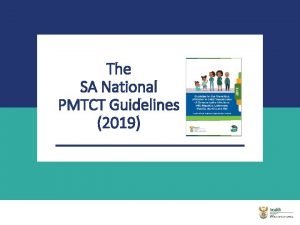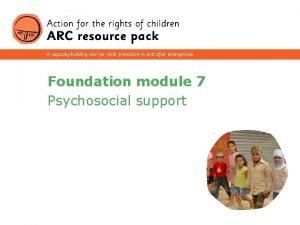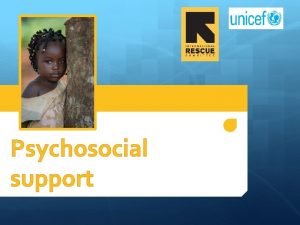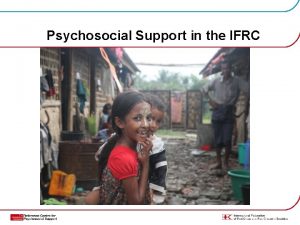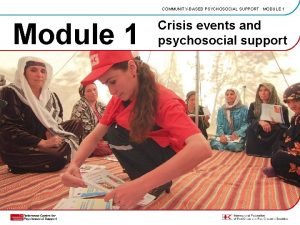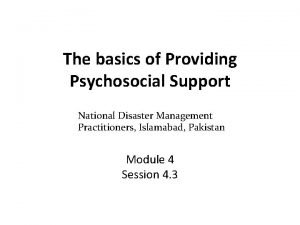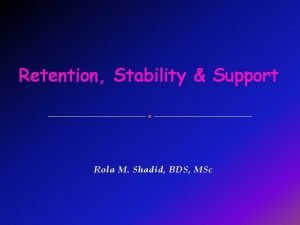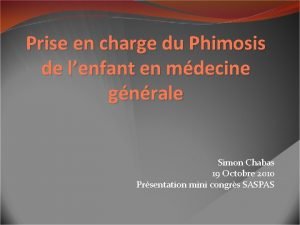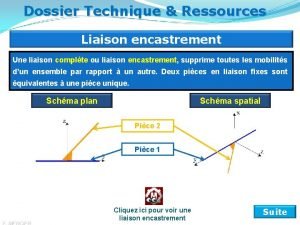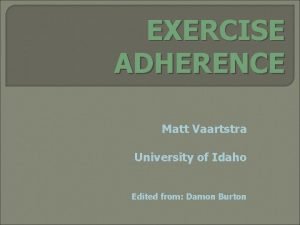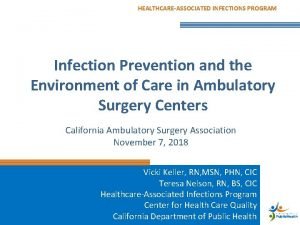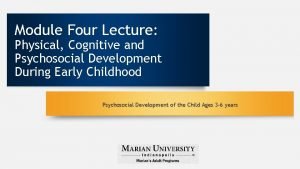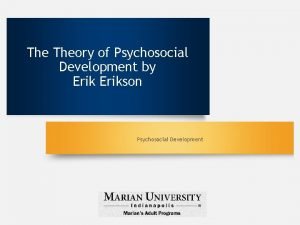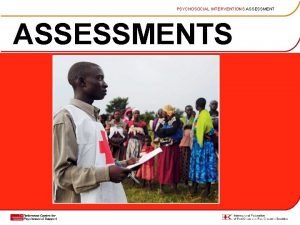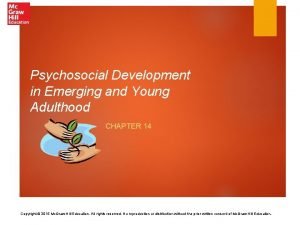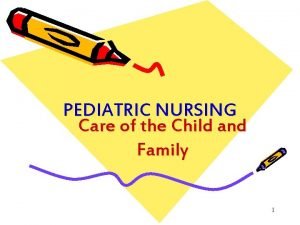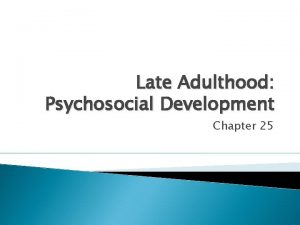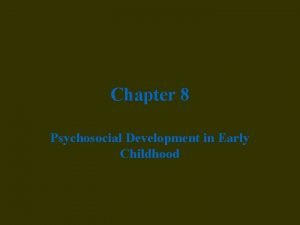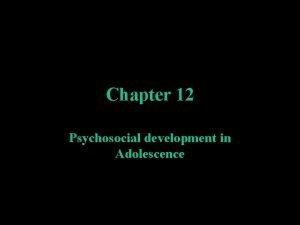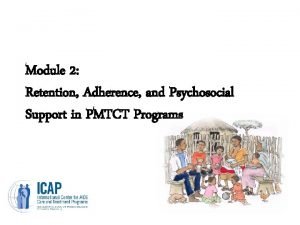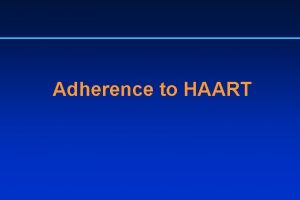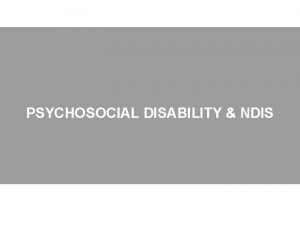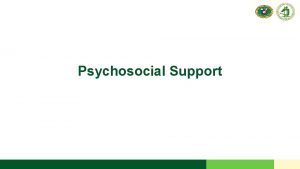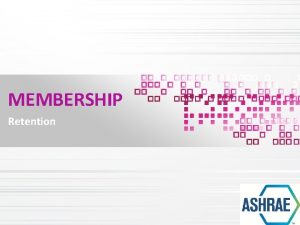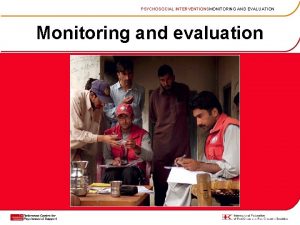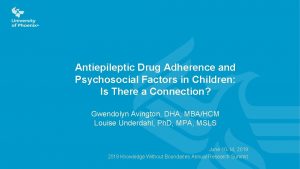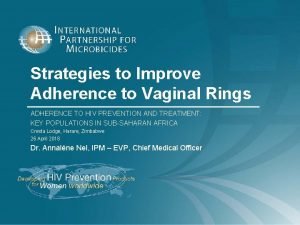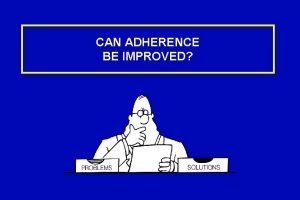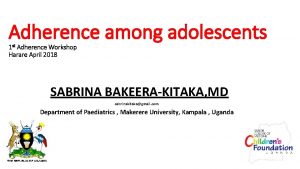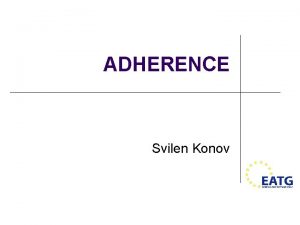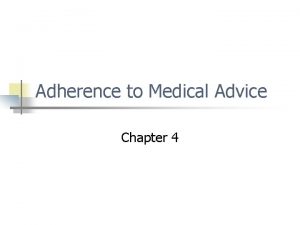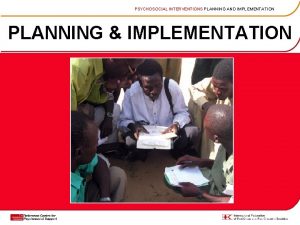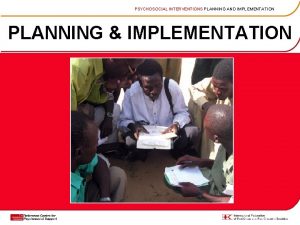Improving Retention Adherence and Psychosocial Support within PMTCT






























- Slides: 30

Improving Retention, Adherence, and Psychosocial Support within PMTCT Services: Implementation Workshop for Health Workers All slide illustrations by Petra Röhr. Rouendaal, 2010

Module 1: Introduction and PMTCT Update

Module 1: Learning Objectives • Know more about workshop participants and trainers • Understand the workshop goal, objectives, and agenda • Discuss changes and updates to the national PMTCT and infant feeding guidelines 1 -2

Workshop Learning Objectives - 1 By the end of this workshop, participants will be able to: 1. Understand the changes to the national PMTCT guidelines and how they should be applied in clinical settings 2. Define the PMTCT spectrum of care 3. Define psychosocial and adherence support in the context of PMTCT services 4. Understand the importance of psychosocial and adherence support to meet the needs of women and families enrolled in PMTCT 5. Identify strategies to improve psychosocial and adherence support within PMTCT programs 6. Use counseling cue cards to conduct ongoing, 1 -3

Workshop Learning Objectives - 2 7. Use checklists to improve pre- and post-test counseling in PMTCT settings 8. Conduct a psychosocial assessment and document key points and next steps, as well as make referrals 9. Use guides to conduct adherence preparation and support sessions with clients and to provide ongoing adherence assessment and follow-up 10. Develop and use an appointment system 11. Use a patient education video to reinforce key PMTCT messages 12. Use improved communication and counseling skills with clients 1 -4

Workshop Agenda 1 -5

PMTCT Update 1 -6

Newly Released WHO Guidelines for HIV Prevention, Care & Treatment, 2009 (and adapted at country level) • • Antiretroviral drugs for treating pregnant women and preventing HIV infection in infants (‘PMTCT guidelines’) Infant feeding in the context of HIV Antiretroviral therapy for HIV infection in adults and adolescents Antiretroviral therapy for HIV infection in infants and children 1 -7

Principle Objectives of the PMTCT Guidelines • Maximally reduce the risk of MTCT • Improve maternal and infant survival • Maximize effectiveness of PMTCT, minimize side effects for mothers and infants, and preserve future HIV care and treatment options 1 -8

Rationale Underlying PMTCT Guidelines Changes • Recognizes the importance of addressing maternal health status and ensuring ART for women eligible for treatment • Extends the duration of prophylaxis throughout most of the period of exposure • Emphasizes the importance of using multidrug regimens • Recommends a single approach for ART prophylaxis (Option A or Option B) on national or subnational level 1 -9

Two Key Approaches for PMTCT Maternal lifelong ART Lifelong ART for HIV-infected women in need of treatment for their own health*, which is also safe and effective in reducing MTCT Highlights importance of CD 4 testing to determine ART Maternal/Infant ART prophylaxis eligibility ARV prophylaxis to prevent HIV transmission from mother to child during pregnancy, delivery and breastfeeding for HIV-infected women 1 -10 not in need of treatment

Key WHO Recommendations 1. Lifelong Antiretroviral Treatment for Pregnant Women who Qualify: Earlier ART initiation to improve maternal health and infant outcomes 2. Maternal-Infant Antiretroviral Prophylaxis: Earlier initiation and longer provision of ARV prophylaxis for HIV-infected pregnant women who do not need ART for their own health, with continued (maternal/infant) prophylaxis during breastfeeding 3. Infant Feeding: Improve HIV-free survival of HIV-exposed Infants 1 -11

I. Maternal Lifelong Antiretroviral Treatment 1 -12

Immunologic and Clinical Criteria for Lifelong ART WHO clinical stage CD 4 <350 cells/mm 3 CD 4 >350 cells/mm 3 Stage I ART ARV prophylaxis Stage 2 ART ARV prophylaxis Stage 3 ART Stage 4 ART 1 -13 WHO 2009

CD 4 Testing Critical to Identify Pregnant Women Eligible for ART % pregnant women eligible for ART, n=3, 736, The MTCT-Plus Initiative, 20032008 Not eligible 48% n=1, 777 Eligibility by CD 4+ and WHO stage (n=1, 959) 100% 96% 75% Eligible 52% n=1, 959 50% 25% 20% 0% Eligible by CD 4+ WHO stage 1 -14 Dugan , Carter, JAIDS 2010

Women Eligible for ART Are at High Risk for MTCT and Mortality Eligible for ART Pregnant women in Zambia, 2002, eligible for ART by current WHO criteria (n=1, 025) Not eligible for ART Proportion of MTCT by 6 weeks 87. 5% 12. 5% Proportion of MTCT after 6 weeks 87. 5% 12. 5% Maternal mortality 24 months after delivery 92% 8% 1 -15 Kuhn, AIDS 2010

Recommended Regimens for ART Eligible Pregnant Women & Their Infants MATERNAL TREATMENT Start ART as soon as possible for women with CD 4 < 350 or WHO Clinical Stage 3 or 4 Initiate ART at any gestational age REGIMENS Preferred Regimen Alternative Regimen AZT + 3 TC + NVP TDF + 3 TC(FTC) + NVP AZT + 3 TC + EFV* TDF + 3 TC(FTC) + EFV* *EFV to be avoided in 1 st trimester INFANT ARV Prophylaxis Infants (breast feeding and formula feeding): Once daily NVP or twice daily AZT from birth until 4 - 6 weeks of age 1 -17 WHO 2009

Regimen Choice for ART Eligible Women (adapt to national guidelines) • Recommended regimens parallel WHO adult ART guidelines – AZT + 3 TC backbone ‘preferred’ for PMTCT • Demonstrated safety and efficacy of AZT + 3 TC – EFV more acceptable for PMTCT • Initiate after first trimester • Effective contraception required postpartum – Each regimen carries drug specific risks and toxicities • Overall low risk of severe toxicities – Neural tube defects associated with EFV during first trimester (very rare event) – Hepatotoxicity/hypersensitivity associated with NVP particularly in women with liver dysfunction/hepatitis – TDF contraindicated with renal dysfunction • Balance in favor of protecting maternal health and preventing 1 -18 infant infections

Considerations for Choice of Infant Prophylaxis Regimen When Eligible Mother Receives ART AZT • Twice daily • Toxicity rare: anemia, neutropenia • Recommended in 2006 guidelines and currently in use in the field • Resistance mutations rare • Not effective for prevention of BF transmission NVP • Once daily • Toxicity rare: rash • Efficacious for prevention of BF transmission – May be especially useful if maternal ART is initiated late • High rate of NNRTI resistance in babies who become infected • Not studied in context of maternal ART during BF – Risk of toxicity if mom and baby both on NVP 1 -19

II. Maternal-Infant Antiretroviral Prophylaxis Option A -or- Option B 1 -20

Immunologic and Clinical Criteria for PMTCT Antiretroviral Prophylaxis (Option A or Option B) WHO clinical stage CD 4 <350 cells/mm 3 CD 4 >350 cells/mm 3 Stage I ART ARV prophylaxis Stage 2 ART ARV prophylaxis Stage 3 ART Stage 4 ART 1 -21 WHO 2009

Option A 1 -22

Prophylaxis Regimens for Pregnant Women & Their Infants Option A MATERNAL ANTIRETROVIRAL PROPHYLAXIS Initiate as early as 14 weeks gestation through delivery REGIMENS Antepartum Intrapartum Postpartum Daily AZT from 14 wks sd-NVP, AZT + 3 TC* AZT + 3 TC for 7 days* *sd-NVP and AZT+3 TC intra- and post-partum can be omitted if mother receives > 4 wks AZT during pregnancy INFANT ANTIRETROVIRAL PROPHYLAXIS Breastfeeding Infant: Once daily NVP from birth through duration of breastfeeding until one week after last exposure to breast milk** Non-breastfeeding Infant: Once daily NVP or sd-NVP + twice daily AZT from birth to 4 -6 weeks of age * *Infant feeding guidelines recommend breast feeding up to 12 months of age 1 -23 WHO 2009

Option B 1 -24

Prophylaxis Regimens for Pregnant Women & Their Infants - Option B MATERNAL ANTIRETROVIRAL PROPHYLAXIS • Initiate as early as 14 weeks gestation through delivery • If breast feeding , continue until 1 week after weaning RECOMMENDED PROPHYLAXIS REGIMENS AZT + 3 TC + LPV/r AZT + 3 TC + ABC AZT + 3 TC + EFV TDF + ETC (FTC) + EFV INFANT ANTIRETROVIRAL PROPHYLAXIS Breastfeeding and Non-breastfeeding Infants: Daily NVP or twice daily AZT from birth until 4 -6 weeks of age 1 -25 WHO 2009

III. Infant Feeding 1 -27

Infant Feeding Recommendations, ONE NATIONAL infant feeding strategy BREASTFEEDING IN THE PRESENCE OF ARV INTERVENTIONS • Exclusive breastfeeding for the first 6 months of life • Introduce complementary foods at 6 months • Continued breastfeeding up to 12 months of life (Breastfeeding should then only stop once a nutritionally adequate and safe diet, without breastmilk, can be provided OR AVOID ALL BREASTFEEDING • Formula provision at national level – NO AFASS Assessment 1 -28

PMTCT Update Summary • Earlier diagnosis and treatment of HIV with ART CD 4 ≤ 350 cells/mm 3 , Stage III, IV* • Prophylaxis started earlier and longer duration Regimens initiated at 14 weeks gestation and continued throughout duration of breastfeeding • Safer infant feeding practices to maximize HIV-free survival Exclusive breastfeeding for 6 months, with breastfeeding continued through 12 months in the presence of maternal/infant prophylaxis *critical importance of CD 4 testing during pregnancy to determine ART eligibility 1 -29

Implications for Adherence Support? • PMTCT does not end at delivery – need to support adherence throughout the entire duration of PMTCT care and interventions • Higher CD 4 (≤ 350 cells/mm 3) means that there will be MORE pregnant women who need to initiate ART and who will need ongoing adherence support • Earlier initiation of prophylaxis for women not eligible for ART means greater need for adherence support during pregnancy • Extended prophylaxis during breastfeeding means greater need for adherence support postpartum • Mothers need compassionate, consistent and ongoing support to adhere to safe infant feeding practices 1 -30

Any Questions? 1 -31
 Pmtct guidelines 2019
Pmtct guidelines 2019 A sense of belonging improving student retention
A sense of belonging improving student retention 7 psychosocial support
7 psychosocial support Types of psychosocial support
Types of psychosocial support Psychosocial approach definition
Psychosocial approach definition Psychosocial module 1
Psychosocial module 1 Types of psychosocial support
Types of psychosocial support Exercise behavior and adherence
Exercise behavior and adherence Support stability retention
Support stability retention Adhérence préputiale traitement
Adhérence préputiale traitement Liason encastrement
Liason encastrement Liaison démontable
Liaison démontable Declakon
Declakon Cdph adherence monitoring tools
Cdph adherence monitoring tools Psychosocial and aesthetic factors
Psychosocial and aesthetic factors Define physical cognitive and psychosocial development
Define physical cognitive and psychosocial development Signal words example
Signal words example Psychodynamic theory erikson
Psychodynamic theory erikson Relaxation response technique
Relaxation response technique Psychosocial environment
Psychosocial environment Psychosocial information
Psychosocial information Chapter 7 human growth and development
Chapter 7 human growth and development Psychosocial development in young adulthood
Psychosocial development in young adulthood Psychosocial tasks
Psychosocial tasks Late adulthood psychosocial development
Late adulthood psychosocial development Erikson's psychosocial crisis
Erikson's psychosocial crisis Industry vs inferior
Industry vs inferior Generativity vs stagnation
Generativity vs stagnation Psychosocial development in early childhood
Psychosocial development in early childhood Psychosocial development in adolescence
Psychosocial development in adolescence Chapter 10:2 physical changes of aging
Chapter 10:2 physical changes of aging
